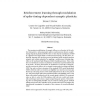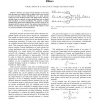59 search results - page 7 / 12 » A spiking neuron model: applications and learning |
NECO
2007
13 years 7 months ago
2007
The persistent modification of synaptic efficacy as a function of the relative timing of pre- and postsynaptic spikes is a phenomenon known as spiketiming-dependent plasticity (...
NIPS
2007
13 years 9 months ago
2007
Reward-modulated spike-timing-dependent plasticity (STDP) has recently emerged as a candidate for a learning rule that could explain how local learning rules at single synapses su...
IJCNN
2007
IEEE
14 years 1 months ago
2007
IEEE
— Neurons are point process systems, in the sense that the inputs and output which are spike trains can be treated as point processes. System identification of a point process s...
ICANN
2005
Springer
14 years 1 months ago
2005
Springer
Spike synchronisation and de-synchronisation are important for feature binding and separation at various levels in the visual system. We present a model of complex valued neuron ac...
JCNS
2010
13 years 6 months ago
2010
Binocular rivalry occurs when two very different images are presented to the two eyes, but a subject perceives only one image at a given time. A number of computational models for...


